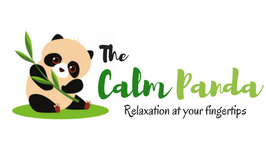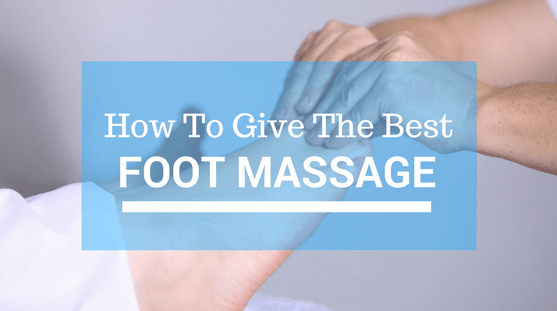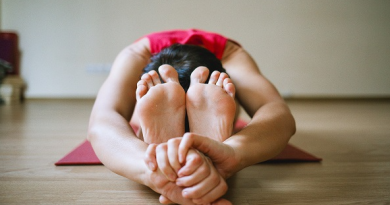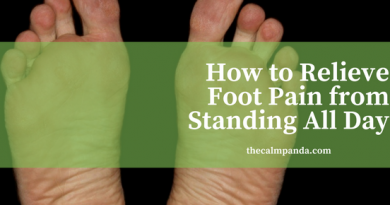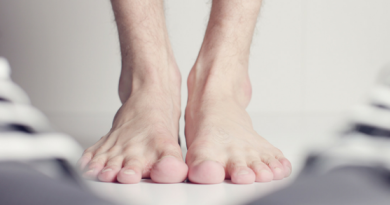How To Give A Foot Massage: 10 Tips For The Best Foot Rub Ever
Like cooking, learning how to give a foot massage is an achievement everyone should include on their bucket lists. Foot massage, after all, is a gift that keeps on giving.
It’s not something couples only do during foreplay, although that’s among its many uses. Foot massage, like a hug, is a gesture of love and caring for someone else–be it your mother, friend, sibling or romantic partner.
Unfortunately, few people–excluding the massage therapists–know how to do it right.
Perhaps it’s because you get tired too quickly or just clueless about foot massage techniques. Whatever the case, lack of knowledge is the reason why we enjoy receiving foot massage more than giving one.
This guide provides basic knowledge and skills that will help you learn how to give the best foot massage like a pro.
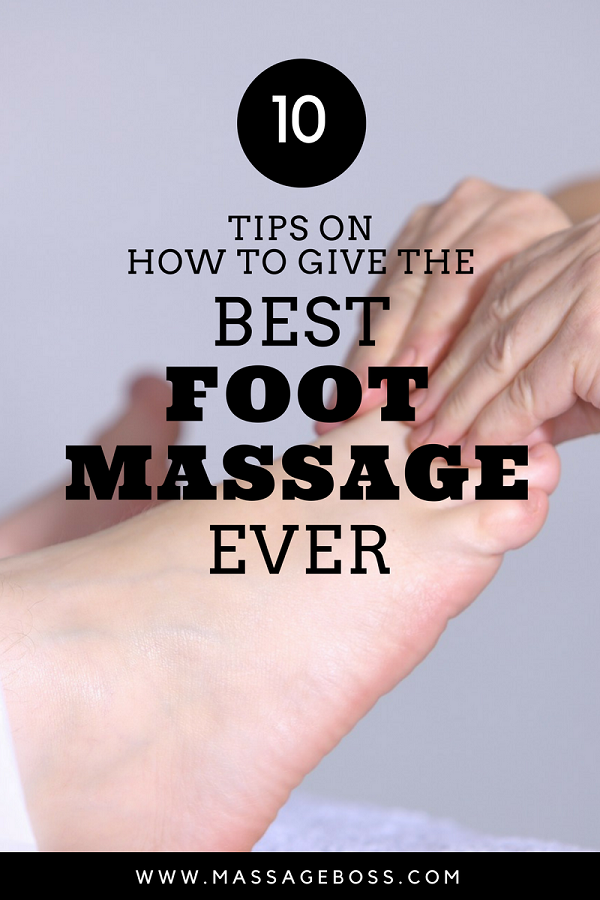
Benefits of Foot Massage.
In a previous article, I’ve already outlined some of the known benefits of a foot massage according to research. They include improved circulation, reduced muscle tension, less stress as well as relief from plantar fasciitis and diabetic neuropathy.
But there are actually more, and you’d be surprised how a simple foot rub can lead to the following:
Reduced edema among pregnant women.
Edema or swelling of the legs, ankles, and feet among expectant mothers is a normal phenomenon. It’s the body’s response to the increased level of the hormone relaxin, which basically prepares the pelvic ligaments for childbirth.
The body retains more fluid while the growing uterus compresses the veins, causing the blood to accumulate in the lower extremities.
There are different ways to relieve edema, and foot massage during pregnancy is one of them.
In 2007, a study in Manisa, Western Turkey involved 80 pregnant women who were divided into two groups. The control group received the usual prenatal care while those in the other group each received a 20-minute foot massage every day for 5 days.
After the experiment, they discovered that women who received foot massage had a lower circumference and less edema than those who didn’t.
Improved sleep.
In a 2011 study published in the Midwifery, 65 postpartum women from two centers in Taiwan were selected because they all complained of poor sleep quality. Again, they were divided into two–a control group and an experimental group who received a 30-minute foot reflexology at night for five days.
Using Pittsburgh sleep quality index (PSQI), the authors discovered that those who received foot massage significantly improved their quality of sleep.
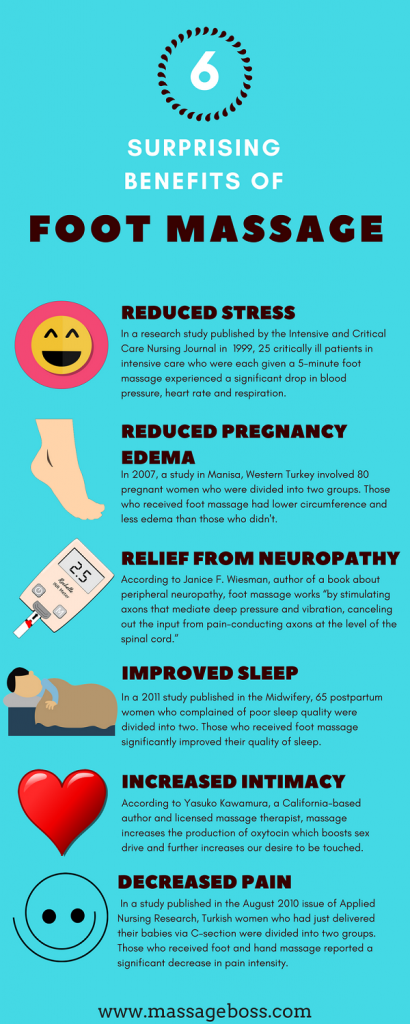
Increased intimacy among couples.
There’s actually a science behind the widespread use of massage–particularly foot massage–during foreplay.
According to Yasuko Kawamura, a California-based author and licensed massage therapist, massage increases the production of oxytocin.
This naturally-occurring chemical is also known as “bonding” or “cuddling” hormone. It boosts sex drive and further increases our desire to be touched.
However, foot massage doesn’t have to be sexual all the time. For non-couples, it can be a good bonding activity, as long as you apply the right touch and prepare a less romantic environment.
Decreased pain.
Although it won’t totally eliminate it, massage is a good way to relieve pain. In a study published in the August 2010 issue of Applied Nursing Research, Turkish women who had just delivered their babies via C-section were divided into two groups.
The control group received the usual pain interventions while those from the other group all received foot and hand massage for a certain period. Those from the latter group reported a significant decrease in pain intensity.
Also Read: How To Massage Shoulders And Neck In 5 Easy Steps
Quickie or Full-on?
Life can be too busy that we sometimes think it’s impossible to squeeze foot massage into our schedules. However, a foot massage shouldn’t consume most of your time.
If time is of the essence, a five-minute or even a three-minute massage can do the trick.
Remember, you’re not doing a full-body massage that can take up to an hour to complete.
It’s all in the mind.
A good foot massage requires focus. Imagine foot massage as an act of transferring and bringing energy and relaxation to the receiver. You won’t be able to do this if you’re full of negativity or not in the mood to give massage.
A healing touch only comes from a mind fully focused on positive things. Never give massage if you think it’s only a burden or a way to release your own stress.
Clear your mind and intentions. Or better yet, connect with your partner by breathing together. You can do this by putting your hands on your partner and matching your breath with his/hers during the entire session.
Get feedback.
Foot massage shouldn’t necessarily be a passive activity. You as the receiver is free to say what massage you prefer, where to apply it as well as how deep or fast it should be.
A good foot massage depends on healthy feedback so the giver must always ask the right questions and the receiver must always reciprocate it with honest answers.
For starters, there are things you must avoid doing when giving foot massage.
Be careful when using your fingers because too light a touch may tickle the receiver, leading to a less enjoyable massage.
Also, avoid massaging over bony parts. A relaxing massage is done on muscles, not bones. Even more painful is bone-on-bone massage wherein you use the bony parts of your body (e.g., elbows) to massage the receiver’s bones.
It’s extremely painful, and may even lead to injuries if you’re not careful.
Not for everyone.
No matter how calming it is, foot massage is not applicable to everyone. In fact, massage can bring more harm than good in some cases. These include fever, fractures, varicose veins, recent injury, high blood pressure, wounds, bruises, and infections, just to name a few.
Remember, if you’re not sure if massage is safe for you, or if you’re suffering from a medical condition, talk to your doctor first. If you want to know more about the contraindications for massage, this article should come in handy.
Preparation is key.
When I was in Nursing school, our instructors always reminded us the importance of hand washing before performing any procedure. This also applies to massage so you can prevent the transfer of microorganisms.
The receiver, meanwhile, should wash and clean the feet because, well, nobody wants to touch dirty feet.
If the receiver is lying on his back, it is recommended to put a bolster or a rolled up towel under the knees to keep the pressure off the lower back.
You can also put a pillow in your lap where the receiver can rest his feet on as you do the massage.
Although you can use massage oils, I prefer lotion because it’s not as slippery. If you insist on using oils, however, choose those that are not too greasy and don’t evaporate too quickly.
I recommend organic oils like olive, jojoba, and grape seed.
Lastly, choose which foot massage technique you will apply. Some of the most popular ones are Swedish, Thai and Shiatsu massage.
There’s also the Chinese-inspired foot reflexology which involves applying pressure on different points of the feet connected to the body organs.
Reflexology focuses on restoring the natural balance of energy in the body (known as “Chi”) and can be done with a foot reflexology chart as a guide. This article focuses on a combination of Thai and Shiatsu.
If you prefer a reflexology-style foot massage, please read this step-by-step guide.
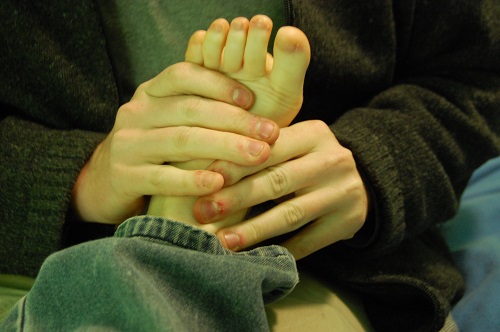
Sight, sound,, and smell.
Apart from preparing yourselves, it’s also important to ensure the environment is conducive to massage.
Turn off your cellphones and have a relaxing music played in the background. Avoid music with distracting lyrics. Choose nature-inspired music featuring the sounds of ocean and river.
Although optional, music stimulates the production of serotonin which is one of the “feel-good” chemicals in the body that help you relax.
Another hormone responsible for sleep and relaxation is melatonin, which is released when you’re in a darker environment. Therefore, keep the room lighting low or use candles to give the place a more spa-like ambiance.
You can also add relaxing aroma through scented candles made with natural ingredients (not the paraffin-based ones that release carcinogenic toxins) and essential oils like lavender, vanilla and rose.
Also Try: Best Essential Oil Diffusers for Large Space
Soak your feet, spa-style.
There’s nothing more relaxing than soaking in a warm foot bath right before the massage.
Foot bath softens the dry and cracked skin on the soles, arches, and heels. It’s optional, but your friends or family will never forget you for giving their feet the ultimate spa experience.
You can make a personalized foot bath at home by pouring warm water into a small tub and adding flowers, marbles and bath salts or essential oils.
If you prefer a Thai foot bath, simply squeeze 1/2 of a lime in a bowl of water and soak your feet in it. Then, take the other half of the lime and scrub it on the bottoms of your feet. This is a good way to remove toxins and soften your feet before the massage.
Another option is to buy affordable home foot spa machines that come with fancier features such as vibration, bubbles, heat and even a waterfall effect. You can also get a hot moist towel and use it to relax the feet before the massage as well as to remove oils and other impurities after the massage.
Massage wisely.
When I was a Nursing student, we were taught about the importance of body mechanics. It means using your body efficiently when doing certain tasks, minimizing the risk of strain injury.
It helped me avoid having back injuries when lifting patients from a wheelchair or preparing hospital beds.
The same principles apply to massage. More often than not, people who give massage end up having painful thumbs and lower back because they have no idea about body mechanics.
Also Read: 11 Quick Remedies to Relieve Foot Pain from Standing All Day
To avoid injuries, always remember these strategies:
*When applying pressure on the soles or arches of the feet, use a “thumb-over-thumb” technique.
*Keep your back straight and let the receiver’s feet rest on a pillow to give you easier access to the areas you will massage.
*Use your body weight when applying pressure on the feet, especially when you’re extending massage up to the calves. This will lift the pressure off your fingers/hands and prevent strain injuries.
*Keep your thumbs in a hook shape when working on the feet. Using straight thumbs when providing massage will only cause pain.
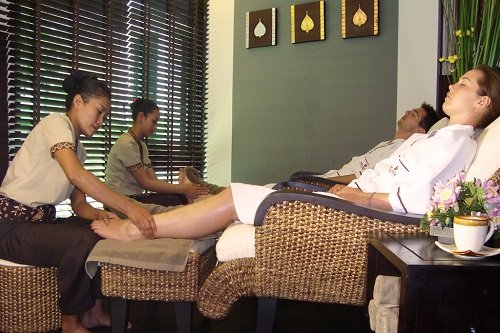
Take it slow.
The longer the massage, the better.
It’s the best way to bond with the receiver and learn more about his/her needs. If you have time to spare, keep the foot massage more relaxing by making longer strokes.
Slowing down is one way of showing you’re not in a rush and sincerely want to give a good foot massage.
Ask the receiver which parts need the most pressure. You can then focus on these areas and massage them repeatedly, depending on the receiver’s preference.
Another way to do it is to divide the foot into small segments and provide deeper, longer massage on each.
Also Read: How To Give An Awesome Back Massage That Melts The Pain Away
Practice makes perfect.
Don’t expect to provide a perfect foot massage at first try.
You can start with a few techniques and use them repeatedly until you become good at them. Afterwards, you can learn more techniques and even advanced lessons about Thai, Shiatsu or Swedish massages.
Yasuko Kawamura, a licensed massage therapist from California and author, suggests the foot massage techniques below for beginners.
*Glide – “Using both hands, glide over the top of the foot. You can also go up to the calf muscles. Or even all the way to the knee.”
*Sponge – “Hold a foot and squeeze like a sponge with and knead, alternating one way at a time on the left side then right side as you move up and down the foot.”
*Spread – “Hold the receiver’s foot with both hands. Spread the top of the foot using the base of the thumbs as you move up and down the foot. Use your body weight for more pressure. Then spread the bottom of the foot using the base of the thumbs and the rest of the fingers as you move up and down the foot.”
*Trench – “Slide the tip of your thumbs between the bones on the top of the foot. Go up and “trench” the valley formed by the extension of the toe bones. You can trench the first half of the foot closer to the toes where the valleys are more distinct. You can also trench all the way to the ankle. Hook your fingers and slow down for more pressure.”
*Finger Slide – “Starting from the ankle, slide your thumb towards the toes on the top of the foot, make small circles in the valley between the extension of the toe bones, and slide out between the toes. Repeat this for all four places between the toes. You can also just slide a finger between the toes.”
